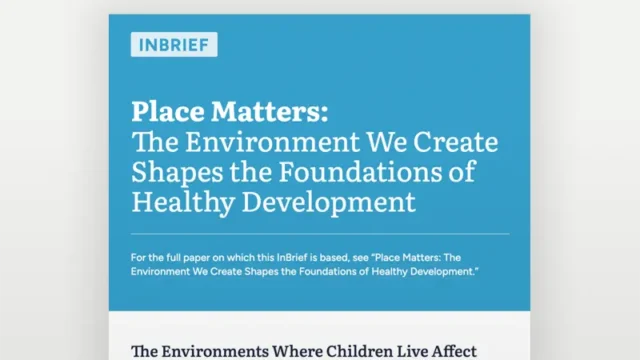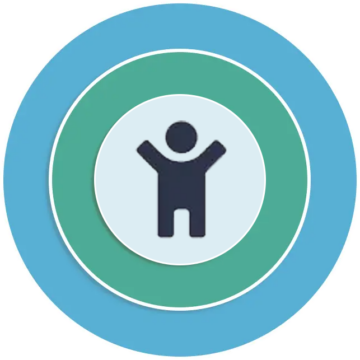InBrief | Place Matters
The Environment We Create Shapes the Foundations of Healthy Development

View full text of the graphic
The Environments Where Children Live Affect their Development, Health, and Well-being
We all experience a continuous stream of influences from the environments in which we live, beginning before birth and continuing throughout our lives. These include a wide range of conditions in our developmental environments—the places where children live, grow, play, and learn—that get built into our bodies and affect the developing brain and other biological systems with potential effects in childhood and well into adulthood.
Beyond the critically important impacts of caregiver-child relationships on early childhood development, the places where people live influence what they are exposed to, affecting maturing biological systems—including the immune, cardiovascular, and metabolic systems. In short, place matters.
Every developmental environment is infused with a combination of positive and negative influences. These are shaped by and deeply rooted in public policies and social history. As a result, many children of color and children living in poverty experience significant exposure to adversity without significant access to opportunity, which can affect development. All children should be able to live in developmental environments that support their lifelong health and well-being. And, all communities have aspects of their built and natural environments that have been designed through decisions made over time. These environments can be re-designed with a science-informed lens and community perspectives to support healthy development. Recommendations for new policy directions are found below and in our Solutions Spotlight.
What Science Tells Us
The conditions of a place can have positive and negative influences on a child’s health and development. Positive influences—during pregnancy and continuing throughout childhood— include access to nutritious food, clean air and drinking water, and safe green space. Negative influences include extreme temperatures, high rates of crime and violence, and a home environment containing toxicants from asbestos, lead, or secondhand smoke. An environment with many positive influences is more likely to support healthy development, and an environment with many negative influences is more likely to result in a higher likelihood of adverse outcomes. For example, access to safe green spaces—such as parks and playgrounds—is associated with better physical and mental health and lower stress, among many other benefits for children and their caregivers.
Environmental exposures early in life can cause lasting changes in developing biological systems.
During prenatal development, billions of cells are produced that later become specialized for different organ systems or functions—each establishing unique properties that allow it to function as part of the brain, lungs, immune system, and more. Exposure to certain infections or toxic substances, as well as lack of access to nutritious foods during the prenatal period, can have lifelong impacts on biological systems and can lead to adverse health outcomes, including cardiovascular disease, respiratory problems, and mental health disorders.
Ensuring fairness of place so that all children can grow up in environments that support their healthy development requires confronting the causes and consequences of systemic racism and intergenerational poverty.
Racism influences multiple dimensions of the natural and built environment that shape the foundations of child development and lifelong well-being.
Racial distinctions, as we know them, are inventions created by societies—and there are no genetic criteria for differentiating these categories. However, the experience of racism gets into the developing body, with significant biological consequences that can begin during pregnancy. Racism manifests in various forms, from overt bigotry and personal discrimination to cultural and structural racism embedded in society, leading to significant hardships for families of color. These systemic inequities, deeply rooted in historical and current policies, result in adverse physical, social, and economic conditions, impacting the health and development of our children, from increased exposure to environmental hazards to chronic stress. There is an urgent need to address these inequities in our policies and practices to provide all children with the opportunity to thrive.
The timing of environmental experiences and exposures can influence short- and long-term effects.
When it comes to development, timing matters. During pregnancy, the immature biological systems of a growing embryo develop at an extremely fast pace, and interactions with the environment around them powerfully shape their development. These systems read conditions in the womb as predictors of what they will encounter after birth and adapt accordingly. This makes these developing systems more susceptible to positive and negative environmental influences than later in life when they have matured. As such, the sensitivity of the brain and other biological systems is typically greater in the prenatal period than in young children. Young children are more susceptible to most adverse exposures than adolescents, and adolescents are more susceptible to many exposures than adults.
Individuals respond differently to their environments due to genetic variation, environmental exposures, and developmental timing, a concept known as heterogeneity.
Despite these individual differences, population-level risk patterns can guide public health actions to reduce diseases like asthma by addressing environmental triggers and improving healthcare access, as demonstrated by successful community initiatives. Broad public health approaches combined with tailored responses, such as policies for safe and healthy housing, are essential to protect the health and development of all children in a community.
Implications for New Directions in Policy
To support the healthy development of our children, we must work together across policy domains within and beyond the early childhood sector.
Broadening the range of policy domains that are viewed as affecting the foundations of early childhood development and lifelong health, including environmental protection, climate change policies, housing, zoning, economic development, criminal legal reforms, and anti-discrimination policies, can help re-shape environmental influences to address disparities and ensure that all children can grow up in homes and neighborhoods free of hazards and full of opportunity.
We must confront the causes and consequences of systemic racism, intergenerational poverty, and other structural inequities.
Every environment is infused with positive and negative influences on health and development, but exposure to hazards and access to opportunity are not distributed equally. To create fairness across places so that all children can grow up in environments that support their healthy development, policy solutions must address the causes and consequences of systemic racism and intergenerational poverty that lead to preventable disparities in child development and lifelong health and well-being.
With a coordinated strategy that looks across sectors, we can positively influence the environments in which all young children live, grow, learn, and play.
By examining a broad array of policies and their associated systems through an anti-racist, early childhood lens, we will advance our ability to connect the dots among:
- Strengthening community assets that support healthy development.
- Preventing, reducing, and/or mitigating environmental conditions that threaten well-being, with particular attention to the most affected communities.
- Understanding how positive and negative environmental influences are built into the body, beginning during pregnancy and early childhood, and result in a strong or weak foundation for future learning, behavior, and health.
These challenges will not be addressed by working within the current boundaries of early childhood policy and practice. Working together across policy domains within and beyond the early childhood sector, we can re-design development environments that build on the existing ecosystem of support for children and caregivers.
See the Solutions Spotlight for inspired examples of place-based policy that supports children’s healthy development. For the full working paper, including related sources, see Place Matters: The Environment We Create Shapes the Foundations of Healthy Development.
 Developmental Environments
Developmental Environments